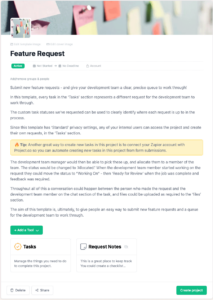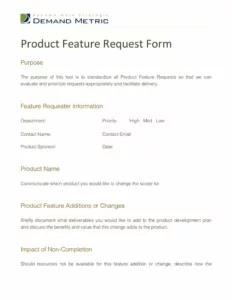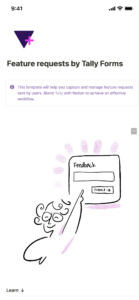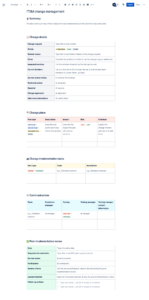Utilizing a prescribed format for proposing software enhancements offers several advantages. Clear and comprehensive requests minimize ambiguity, reducing back-and-forth communication and saving valuable time for both requesters and developers. Standardization also allows for easier prioritization, tracking, and management of incoming suggestions, leading to a more organized and effective development process. Furthermore, it promotes better collaboration and understanding between stakeholders by providing a shared language for discussing software evolution.
This structured method for soliciting and documenting desired changes forms the basis for streamlined development processes and ultimately contributes to the creation of better software. The following sections delve into the key components of these forms, best practices for their use, and strategies for maximizing their effectiveness within a software development lifecycle.
Key Components
Effective forms for requesting software features typically incorporate several key elements to ensure clarity and completeness. These components facilitate efficient processing and implementation by development teams.
1. Title/Summary: A concise, descriptive title summarizes the requested feature. Brevity and clarity are essential for quick understanding and efficient categorization.
2. Description: A detailed explanation of the desired functionality. This section should clearly outline the proposed change, its purpose, and expected behavior.
3. Rationale/Justification: An explanation of the reasons behind the request. This clarifies the value proposition of the feature, explaining why it is beneficial or necessary.
4. Priority: An indication of the urgency or importance of the feature. This helps developers prioritize tasks and allocate resources effectively.
5. Target User/Persona: Identification of the intended user group or persona who will benefit from the feature. Understanding the target audience helps developers tailor the implementation appropriately.
6. Acceptance Criteria: Specific, measurable, achievable, relevant, and time-bound (SMART) criteria that define when the feature is considered complete and functional. This ensures clear expectations and facilitates testing.
7. Attachments/Mockups: Supporting materials such as diagrams, mockups, or user stories that further illustrate the desired functionality. Visual aids can enhance understanding and reduce ambiguity.
Well-defined requests contribute significantly to streamlined development workflows. These components, when used effectively, facilitate clear communication, manage expectations, and ultimately contribute to the delivery of high-quality software enhancements.
How to Create a Software Feature Request Template
Creating a standardized form for requesting software features involves careful consideration of key elements to ensure clarity, completeness, and efficient processing. A well-designed template facilitates clear communication between stakeholders and contributes to a more streamlined development process.
1. Define the Purpose: Clearly articulate the objectives of the template. Determine the specific information required to capture the essence of a feature request effectively.
2. Identify Key Components: Determine essential fields for the template, including a descriptive title, detailed description, rationale, priority level, target user, acceptance criteria, and any supporting attachments.
3. Choose a Format: Select a suitable format for the template, whether a digital document, spreadsheet, or dedicated software tool. Consider accessibility and ease of use for all stakeholders.
4. Develop Clear Instructions: Provide concise and unambiguous instructions on how to complete each field within the template. Clarity minimizes confusion and ensures consistent data quality.
5. Establish a Review Process: Implement a review process to ensure requests are complete, well-formed, and aligned with project goals. This step helps prevent scope creep and ensures alignment with overall product strategy.
6. Test and Iterate: Pilot test the template with a small group of users and gather feedback. Iterate on the design based on feedback to optimize its effectiveness and usability.
7. Train Users: Provide training to all stakeholders on how to effectively utilize the template. This ensures consistent usage and maximizes the benefits of standardization.
8. Maintain and Update: Regularly review and update the template as needed to reflect evolving project requirements and incorporate feedback from users. Maintenance ensures the template remains relevant and effective over time.
A well-structured process combined with a comprehensive template facilitates clear communication, manages expectations, and ultimately contributes to the efficient development of high-quality software.
Standardized forms for requesting software features provide a crucial mechanism for managing the evolution of software products. They ensure clear communication of desired functionalities, facilitate efficient prioritization and tracking, and contribute to a more streamlined development process. Key components such as a clear title, detailed description, rationale, priority level, target user, acceptance criteria, and supporting attachments ensure comprehensive and actionable requests. Establishing a well-defined creation process, including defining the purpose, identifying key components, choosing a suitable format, developing clear instructions, establishing a review process, testing and iterating, training users, and maintaining the template, maximizes its effectiveness.
Leveraging these structured approaches empowers development teams to effectively address user needs, prioritize enhancements, and deliver high-quality software that meets evolving demands. Consistent application of these principles contributes to improved collaboration, reduced development costs, and ultimately, the creation of more valuable and user-centric software products.



